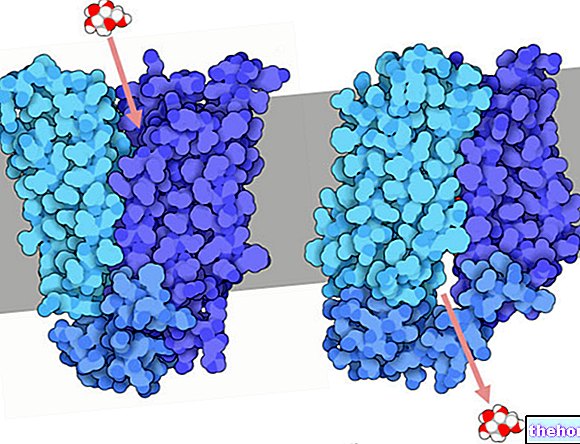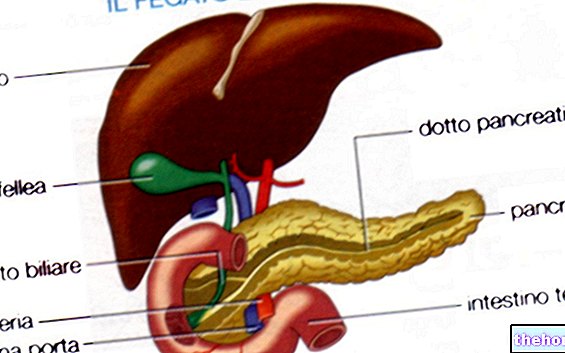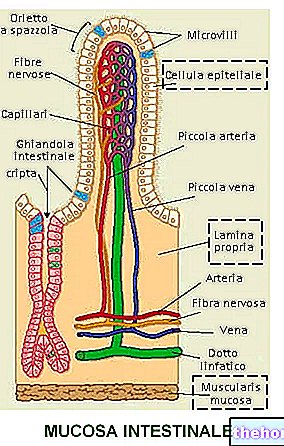Thyroid hormones (T4 - thyroxine - and T3 - triiodothyronine -) are secreted by the thyroid in response to the pituitary hormone TSH, whose production is regulated by the hypothalamic hormone TRH.
TRH: TSH releasing hormone, hypothalamic peptide of 3 amino acids, produced in the parvocellular region of the paraventricular nucleus in a discontinuous way. It stimulates the pituitary secretion of TSH
TSH: thyrotropic hormone, glycoprotein produced by the thyrotropic cells of the pituitary, composed of an α subinity of 92 AA (in common with LH, FSH and hCG) and a β of 192 AA. It has a pulsatile secretion with periods of 2 hours, which increases in the period before sleep Controls the production of thyroid hormones by thyroid follicular cells Through negative feedback it reduces the secretion of TRH.
TSH secretion is inhibited by: thyroid hormones, dopaminergic agonists, somatostatin analogues, glucocorticoids.
Thyroid hormones: they are two and are called respectively triiodothyronine (T3) e thyroxine (T4). Thyroid hormones are produced by thyroid follicular cells in response to the pituitary hormone TSH.
Thyroid hormones:
- They are critical for the brain and somatic development of the child and the metabolic activity of the adult
- They affect the function of every organ and tissue
- They must always be available
There are large deposits available (thyroid follicle colloid and plasma transport proteins) of thyroid hormones, whose synthesis and secretion are strictly regulated by very sensitive mechanisms.
Synthesis of thyroid hormones
To synthesize thyroid hormones you need:
1. tyrosine, made available to thyroglobulin (Tg)
2. IODINE, concentrated in the thyroid cell (thyroid cell) thanks to a specific membrane transport mechanism, the NIS
3. an enzyme that catalyses the organization of IODIUM in Thyroglobulin; this enzyme is called thyroperoxidase or TPO
TSH stimulates the synthesis of thyroid hormones also by promoting the synthesis of thyroglobulin (Tg) by thyrocytes.
Tg is a 660 kD homodimeric protein with a high content of tyrosine residues, produced in the Golgi apparatus and poured onto the apical side of the thyrocyte.
TSH stimulates the expression of NIS (sodium / iodide symporter): pump that transports IODIUM inside the thyrocyte against gradient. It takes advantage of the sodium gradient, which is expelled by the Na / K ATPase pump.
IODINE is then ORGANIFIED in the tyrosine residues of Tg thanks to peroxidation by the enzyme thyroperoxidase (TPO) on the apical membrane of the thyrocyte. This process is TSH-dependent.

TPO catalyzes the formation of T4 from two molecules of DIT (dioidiotyrosine) and the formation of T3 from one molecule of DIT and one of MIT (monoiodiotyrosine).
In the process of synthesis of thyroid hormones, molecules other than T3 and T4 can also be formed, which are however metabolized inside the thyrocyte, recovering the IODIUM and the tyrosine residue.
The circulating thyroid hormones are mainly represented by T4.
80% of circulating T3 derives from the desiodation of T4 in the suburbs.
T4 and T3 circulate bound to plasma proteins:
TBG = thyroxine-binding globulin, each molecule binds one molecule of T4 or T3. It binds 70% of the T4 in circulation and 80% of the T3 in circulation.
TTR = transthyretin, also carries retinol. It links 11% of the T4 in circulation and 9% of the T3 in circulation.
Albumin = Binds 20% of the circulating T4 and 11% of the circulating T3.
The active form at the cellular level is represented by T3, which derives from the metabolization of T4, from which an iodine atom on the outer ring is removed by DESIODASE. Much of T3 is formed inside the target cells.

D1 (type 1 deiodinase) is mainly expressed in the liver and kidney
D2 is mainly expressed in skeletal and cardiac muscle, central nervous system, skin, pituitary, thyroid.
D3 removes an iodine atom on the inner ring of T4 or T3, inactivating them; it is expressed mainly in the placenta, central nervous system and fetal liver.
T3 has 15 times higher affinity for specific thyroid hormone receptors than T4.
ACTIONS OF THYROID HORMONES
- They are necessary for the development of the central nervous system in the fetus and postnatal stages
- Important effects on cerebral differentiation processes, in particular on synaptogenesis, growth of dendrites and axons, myelination and neuronal migration (first weeks of life).
- They are necessary for the development of the fetal skeleton
- They are essential for the maturation of the epiphyseal growth centers (epiphyseal dysgensia)
- They are essential for the normal body growth in the child, and the maturation of the various systems, especially the skeletal one.
- Thermogenetic action
- Effects on glucose metabolism
- Lipolysis and lipogenesis
- Protein synthesis
- Effects on the central nervous system
- Effects on the cardiovascular system
Thermogenetic action
Thyroid hormones contribute in a fundamental way to energy expenditure and heat production, directly regulating the basal metabolism.
This action depends on:
increased mitochondrial oxidative metabolism
increased respiratory enzymes and mitochondria
increased basal metabolic rate
(amount of energy expenditure of a subject in conditions of rest)
increased metabolic activity of all tissues
(increase in the consumption of O2, the production of heat and the speed of use of energy substances)Normal O2 consumption = 250ml / min,
Hypothyroidism »150 ml / min.Hyperthyroidism »400 ml / min
Effects on glucose metabolism
Thyroid hormones:
induce the hepatic production of glucose
increase glycogenolysis and gluconeogenesis; they promote the utilization of glucose by increasing the activity of enzymes involved in the oxidation of glucose
Lipolysis and lipogenesis
- they stimulate hormone-sensitive lipase activity → lipolysis
- they stimulate the synthesis and oxidation of cholesterol and its conversion into bile acids
- lipogenesis: favored the synthesis of fatty acids (↑ synthesis of malic enzyme)
prevailing effect on lipolysis = increases the availability of ac. fats, which can be oxidized and form ATP, used for thermogenesis
Protein synthesis
Increased protein synthesis (structural proteins, enzymes, hormones); trophic effect on the muscle
- They stimulate endochondral ossification, linear growth and maturation of the epiphyseal centers.
- They favor the maturation and the activity of the chondrocytes in the cartilage of the growth plate.
- The effects on linear growth are largely mediated by their action on GH and IGF-1 secretion
- They have an action on the protein matrix and on the mineralization of the bone.
- In the adult, they accelerate bone remodeling with a prevalent effect on resorption. Osteoblasts possess receptors for T3
Effects on the central nervous system
Thyroid hormones regulate the development and differentiation of the central nervous system during fetal life and in the first weeks of life, when they ensure proper myelination of nerve structures
Deficits of thyroid function in the early period involve serious repercussions on the CNS and can compromise the IQ of the subject.
Effects on the cardiovascular system
increase in the number of β 1 adrenergic receptors
increases cardiac contractility
increased heart rate
increases the excitability of the mycellincreases tissue consumption of O2
increases venous return to the heart
Other effects
Thyroid hormones:
- increase intestinal motility
- they favor the absorption of vitamin B12 and iron
- increase the synthesis of erythropoietin
- they increase renal flow and glomerular filtration
- regulate the trophism of the skin and appendages
- they stimulate the endogenous production of other hormones (GH) and have a permissive role on reproductive functions
Other articles on "Thyroid hormone actions: thyroxine and triiodothyronine"
- Thyroid hormones
- Thyroid
- Diseases of the thyroid gland
- Thyroid hormones T3 - T4 and exercise
- Gozzigeni foods
- Hypothyroidism
- Hyperthyroidism
- Triacana



.jpg)







.jpg)


















